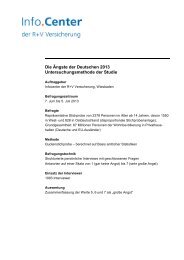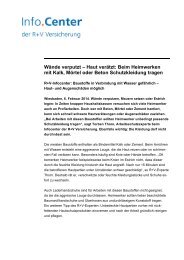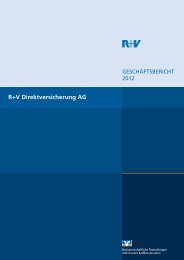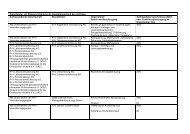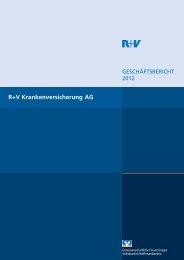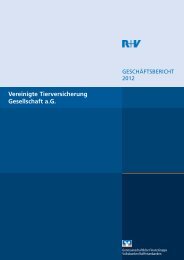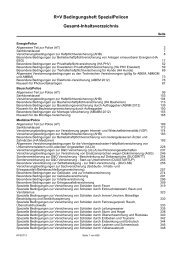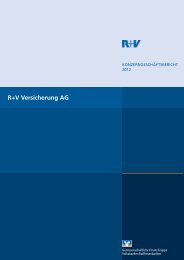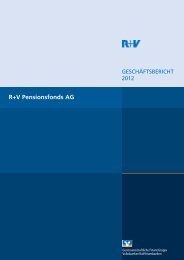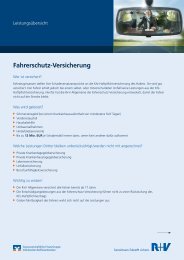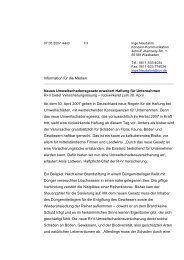Annual Report 2011 - R+V Versicherung
Annual Report 2011 - R+V Versicherung
Annual Report 2011 - R+V Versicherung
You also want an ePaper? Increase the reach of your titles
YUMPU automatically turns print PDFs into web optimized ePapers that Google loves.
10<br />
Business development and basic conditions<br />
OVERALL FIGURES FOR THE SECTOR<br />
<strong>2011</strong> Change from<br />
EUR billion previous year<br />
Gross premium income<br />
domestic<br />
Insurance services from<br />
178.1 – 0.4%<br />
direct insurers 147.7 + 7.0%<br />
The upward trend in property and accident insurance in the<br />
previous year came to an end. Premium income increased to<br />
56.7 bn euros (+ 2.7%). The positive trends in motor insurance,<br />
where premium income increased by 3.5%, made a<br />
crucial contribution to this. According to provisional GDV<br />
information, the other insurance branches also generated<br />
increases in premiums. Claims payments increased to 44.4 bn<br />
euros (+ 2.6%) in <strong>2011</strong>.<br />
Development on the reinsurance markets<br />
<strong>2011</strong> proved to be a challenging year for the reinsurance industry.<br />
The unusual accumulation of severe natural disasters<br />
as well as lower profits from capital investments reduced the<br />
earning power of the sector.<br />
In chronological terms, the first quarter was particularly<br />
catastrophic in the Pacific region and in Eastern Asia. In addition<br />
to severe flooding in Queensland, North Eastern Australia<br />
also had to contend with cyclone Yasi in January which hit the<br />
coast on 3 February at wind speeds of up to 280 km/h. The<br />
New Zealand city of Christchurch was also hit by another severe<br />
earthquake in February. Although the event was barely<br />
noticeable in the European media, insured losses amounted to<br />
significantly more than 10 bn US dollars. Just two weeks later<br />
the biggest loss of <strong>2011</strong> occurred. Measuring 9.0 on the<br />
Richter scale, an earthquake struck Honshu, the main island<br />
of Japan, causing a tsunami. Insured losses are estimated at<br />
more than 30 billion US dollars and make this event the most<br />
expensive earthquake the insurance industry has experienced<br />
to date.<br />
DEVELOPMENTS OF THE LIFE INSURANCE CLASS*<br />
<strong>2011</strong> Change from<br />
EUR billion previous year<br />
Gross premiums written 86.6 – 4.2%<br />
Number of new policies 6.5 million + 2.3%<br />
Total new business premiums 28.7 – 12.2%<br />
*GDV (German Insurance Association) figures (life insurers,<br />
pension investment funds, pension funds), Status January 2012<br />
Driven by, among others, an extreme stormy season in the USA<br />
with hundreds of tornados, which primarily affected the states<br />
of Alabama, Missouri and Tennessee, by the middle of the year<br />
the global financial losses had risen to a value which even exceeded<br />
the previously most expensive year, 2005.<br />
In spite of an active hurricane season with seven named hurricanes<br />
and twelve named tropical storms as well as the flood in<br />
Bangkok, the loss situation did not deteriorate any further in<br />
the second half of the year. Although the losses incurred by<br />
insurance companies over the whole year in <strong>2011</strong> added up to<br />
a high level comparable with the record year of 2005, the reinsurance<br />
industry was in a position to carry the costs thanks to<br />
its good capitalisation and again underlined its importance in<br />
the offsetting of financial losses. The capital strength of reinsurance<br />
companies was also confirmed by the rating agencies<br />
which continued to assess the industry positively due to the<br />
good capitalisation.<br />
Whilst stable to slightly declining ratios were observed in the<br />
renewal negotiations at the beginning of <strong>2011</strong>, rates rises were<br />
recorded from the first quarter primarily in the loss burdened<br />
segments and those affected by natural disasters. The loss<br />
situation, the weak return on capital and the euro crisis also<br />
allow the conclusion of stable to increasing rates for the next<br />
renewals.<br />
In France, <strong>2011</strong> was a year characterised by relatively low losses<br />
in the direct insurance sector. Although the South East of<br />
the country was affected by major flooding at the end of the



